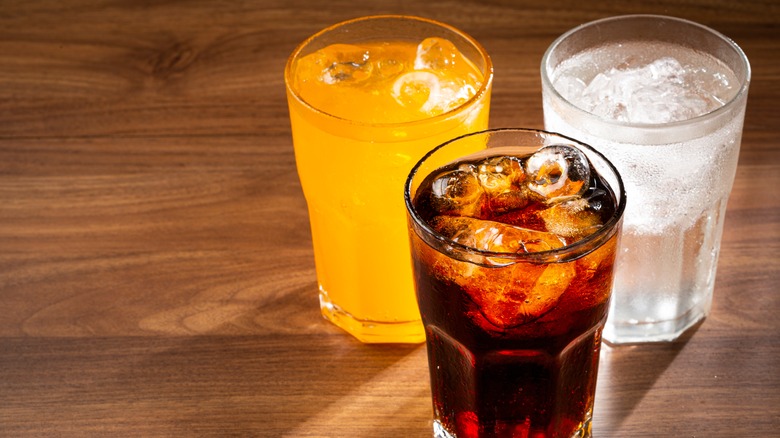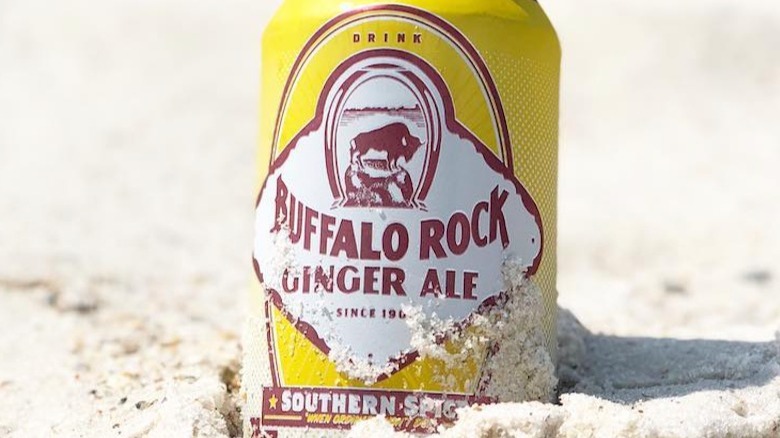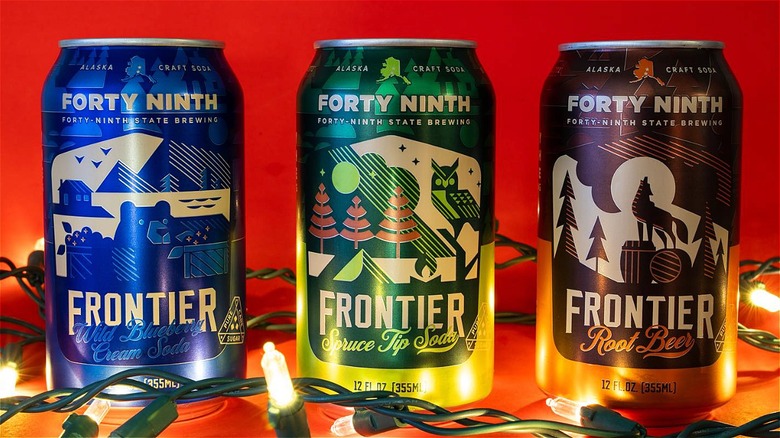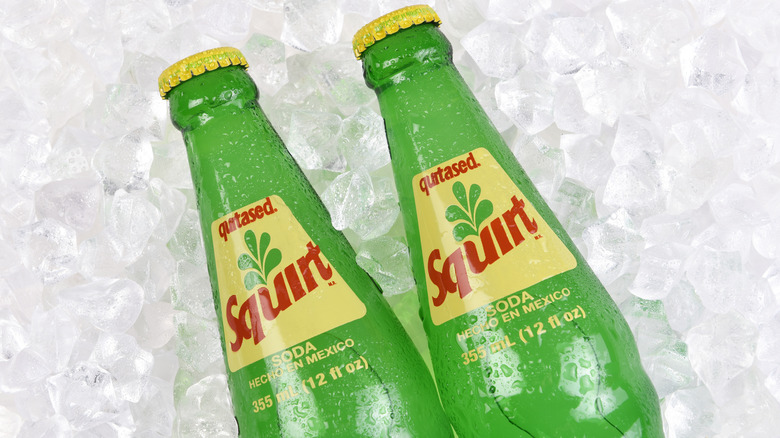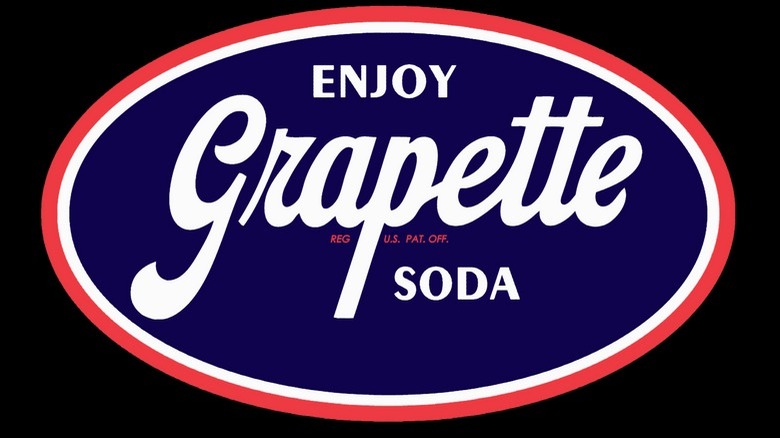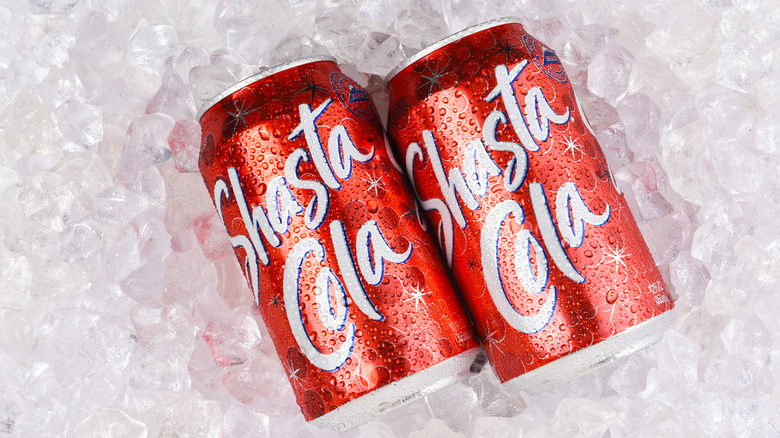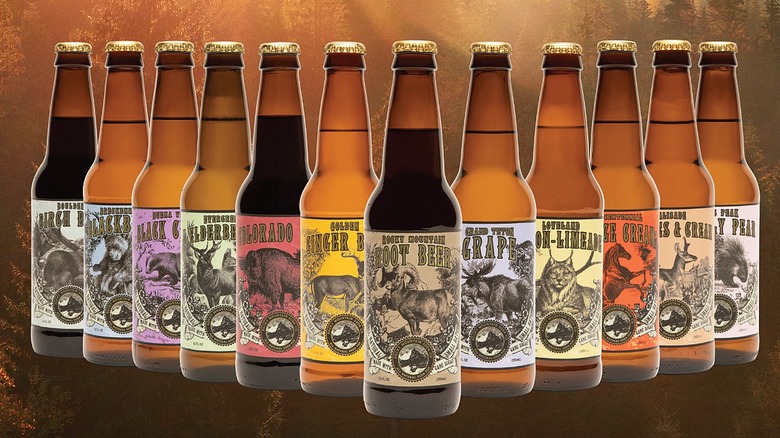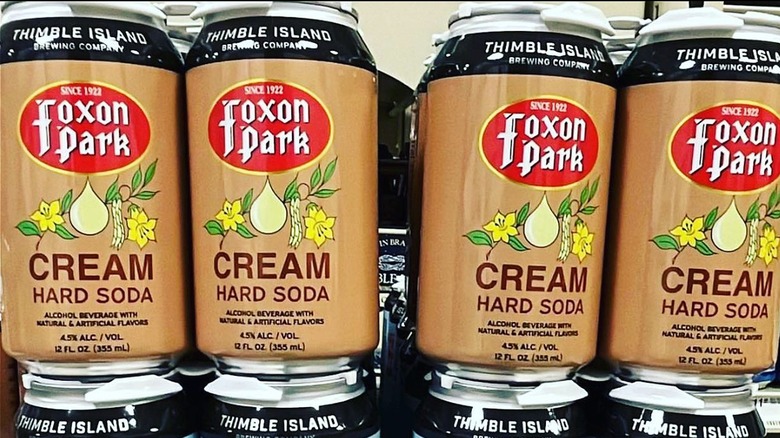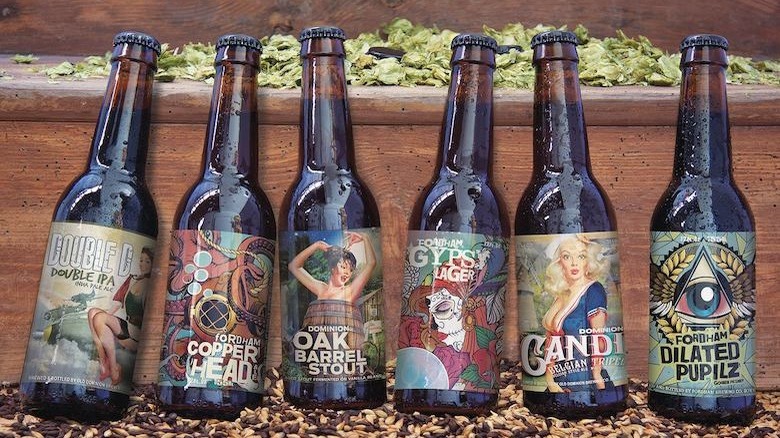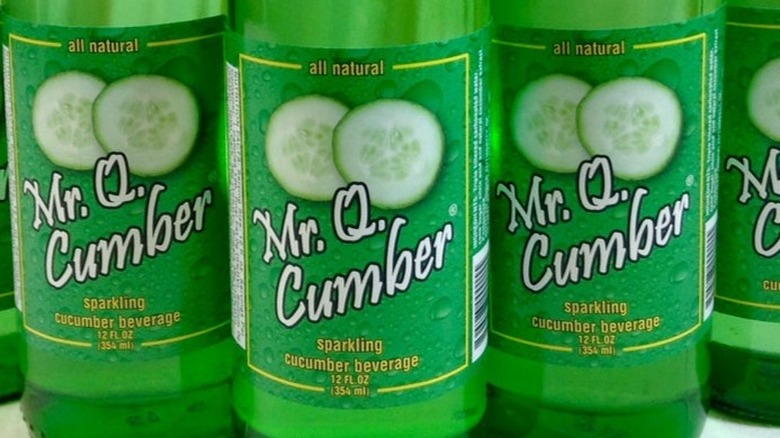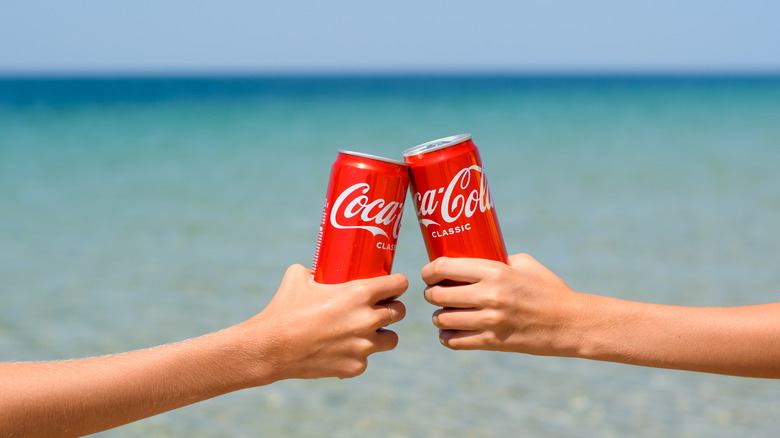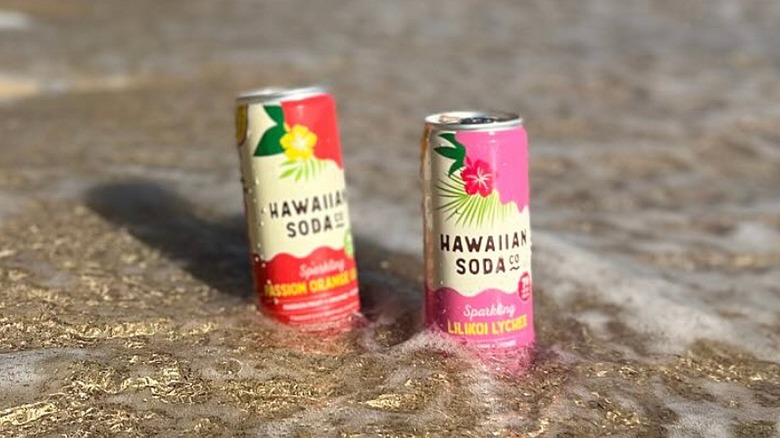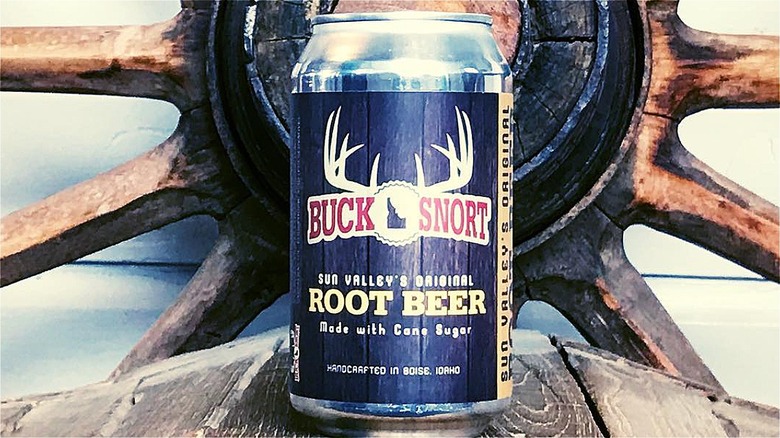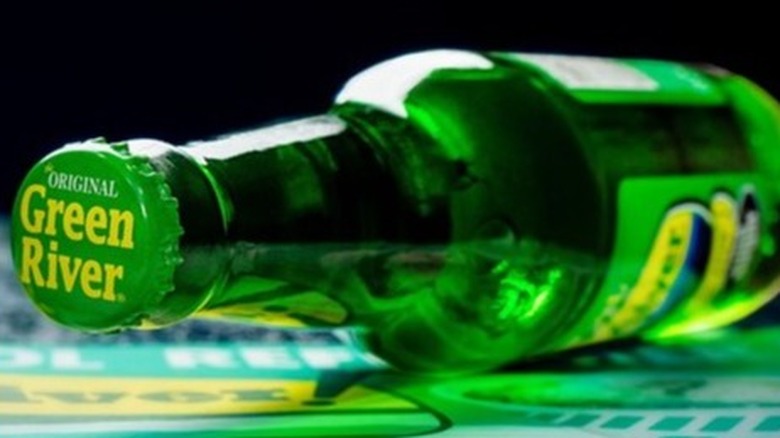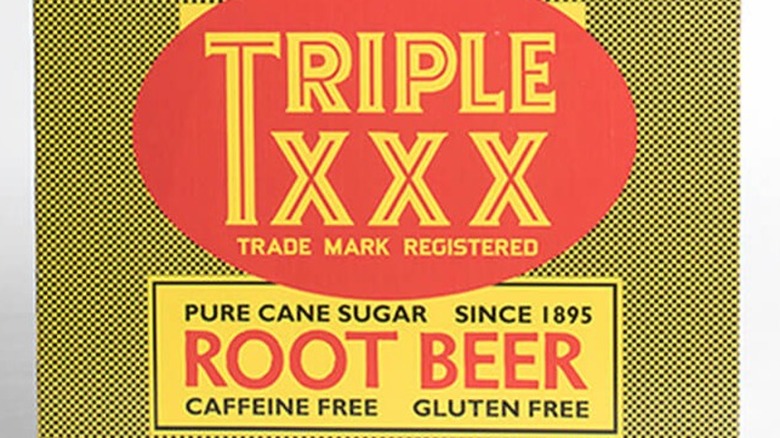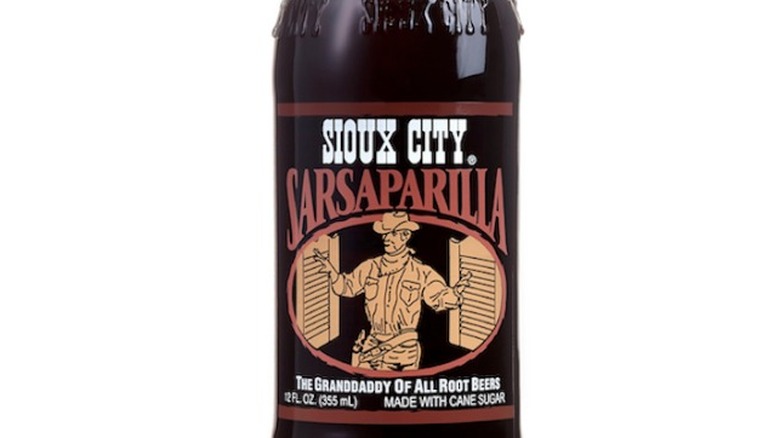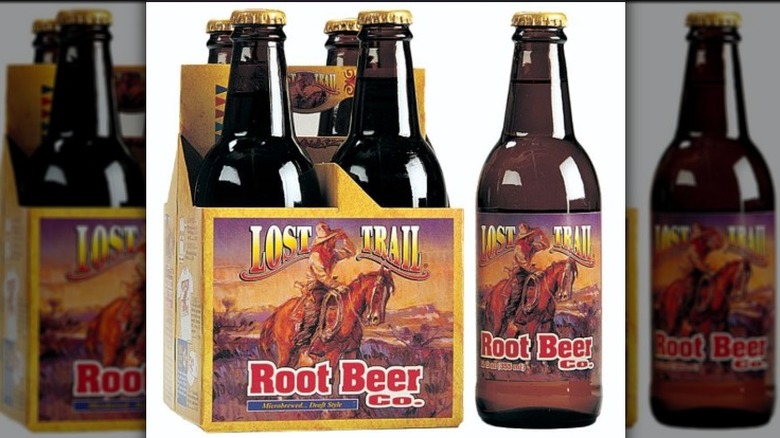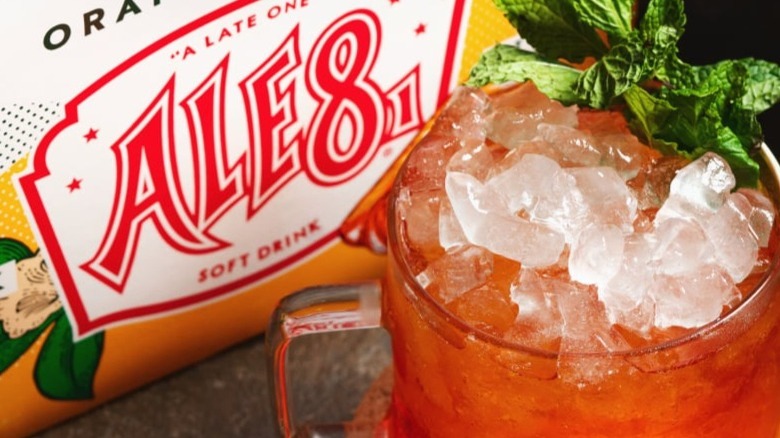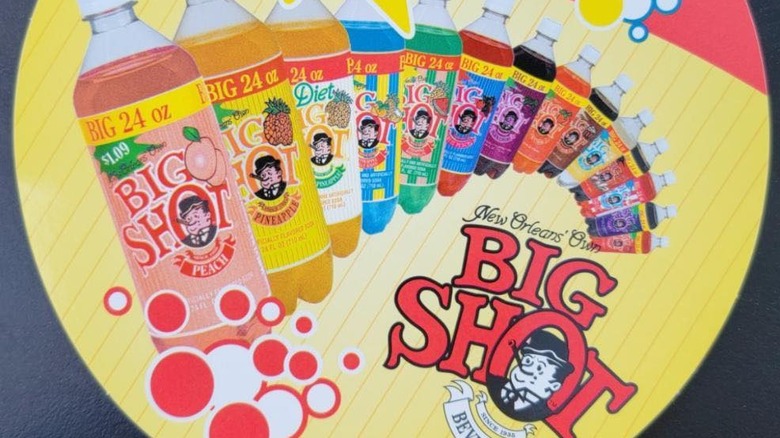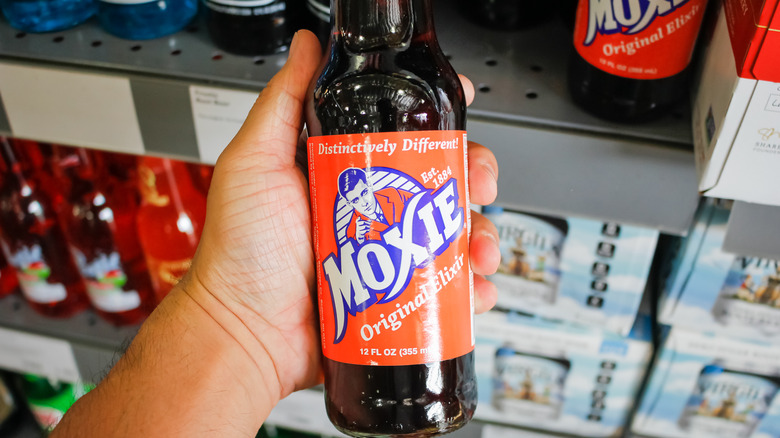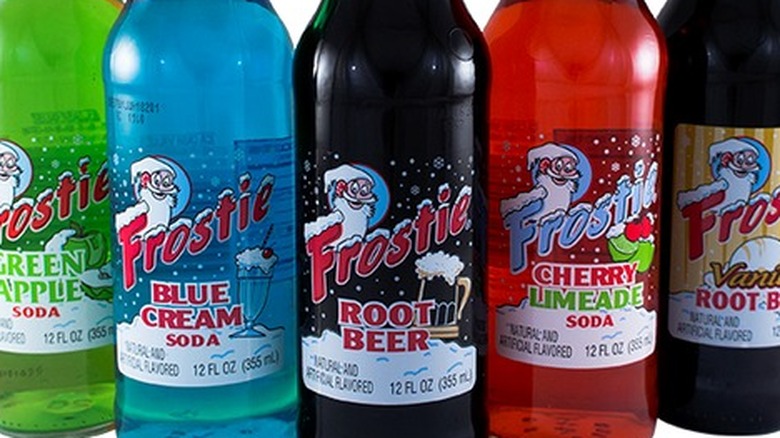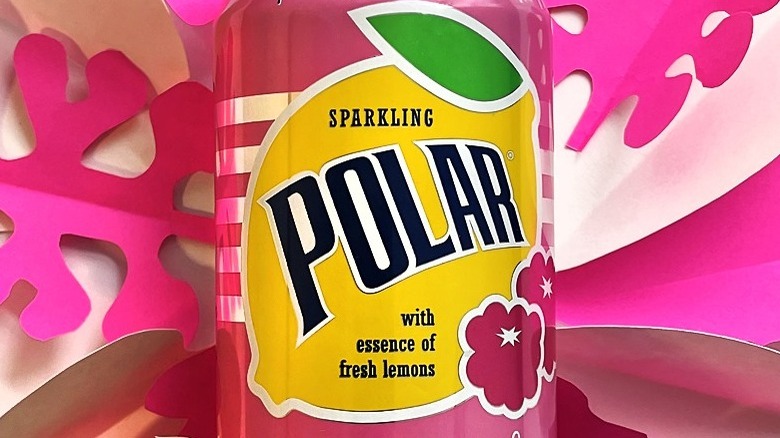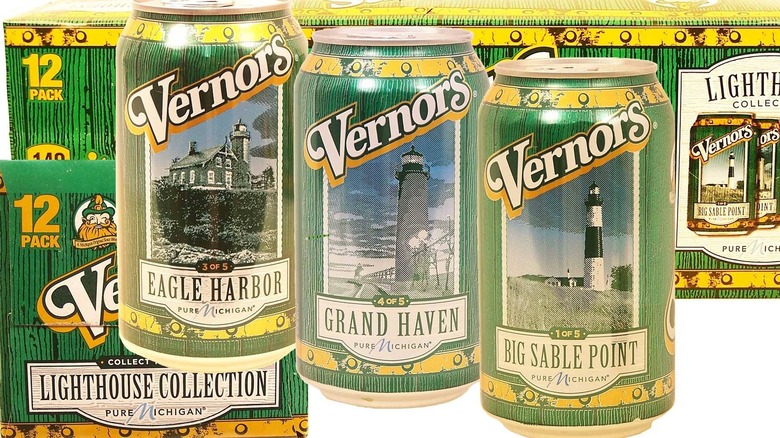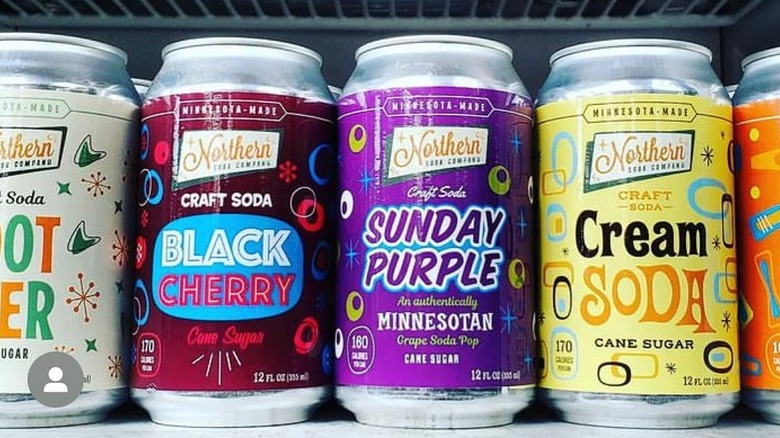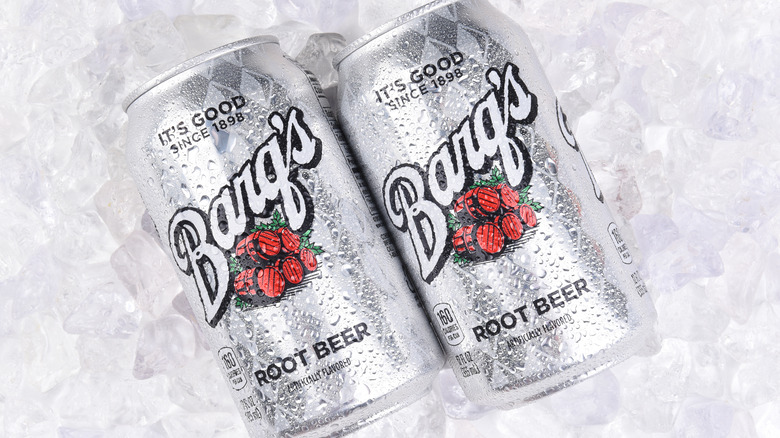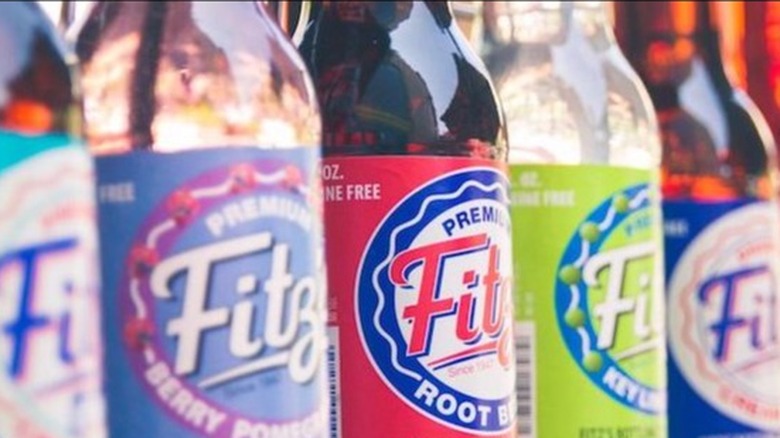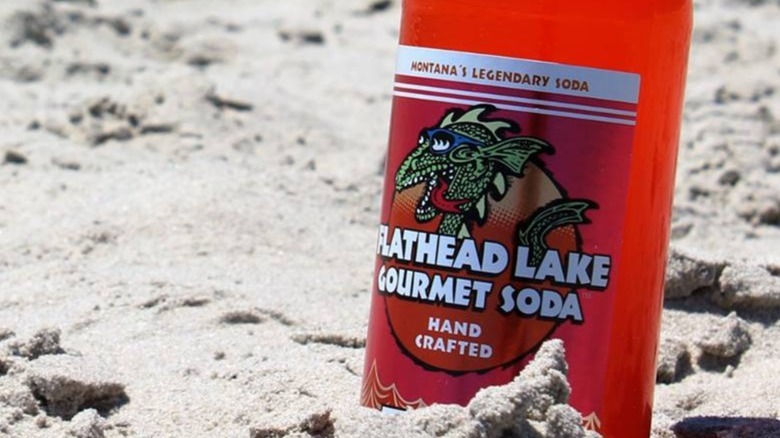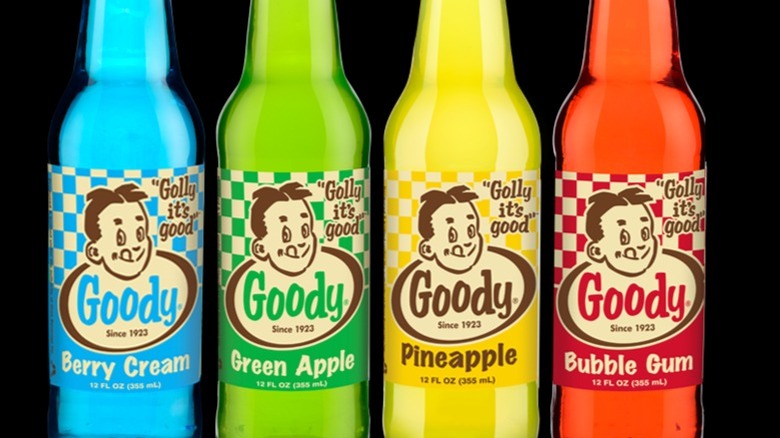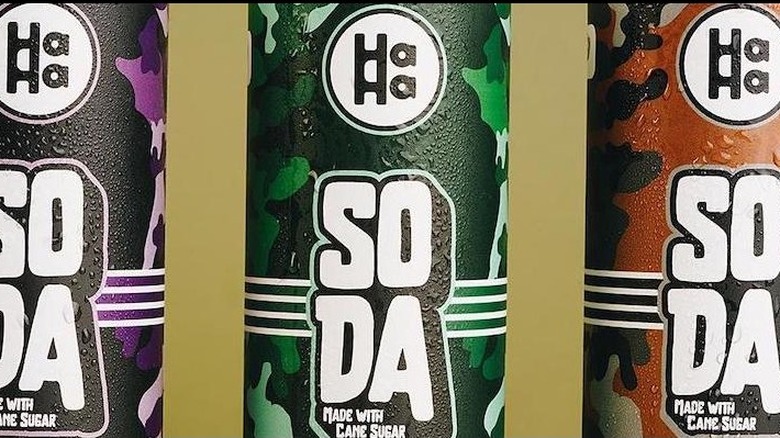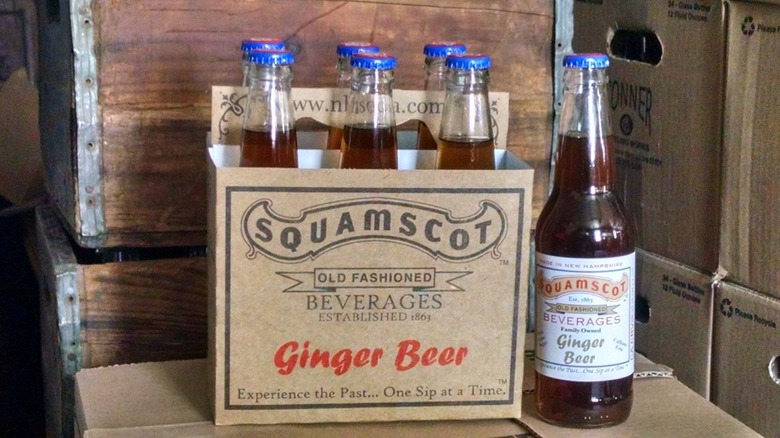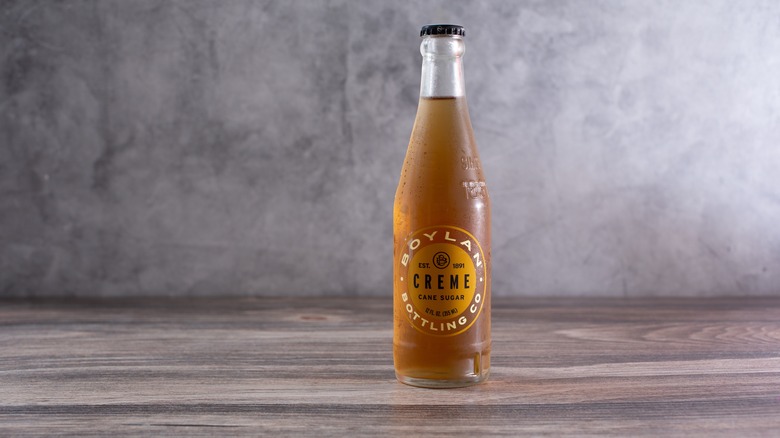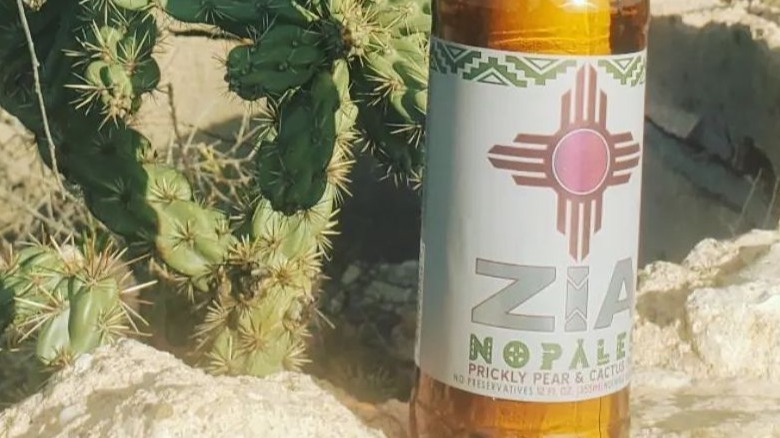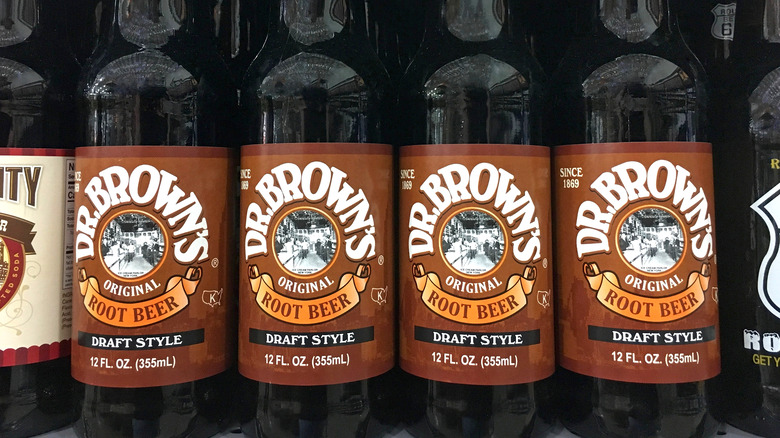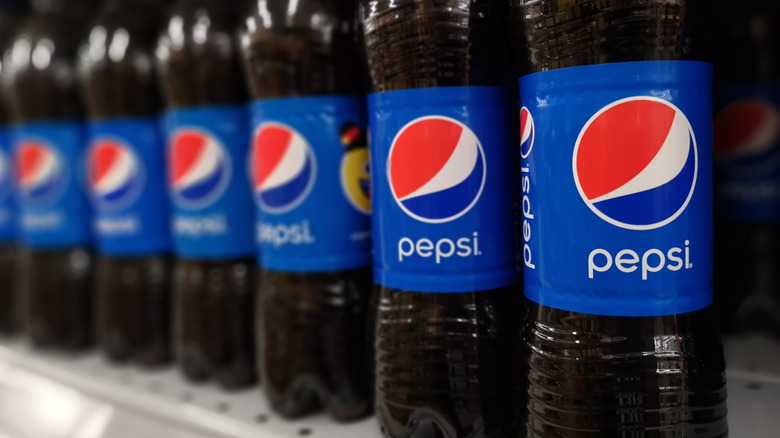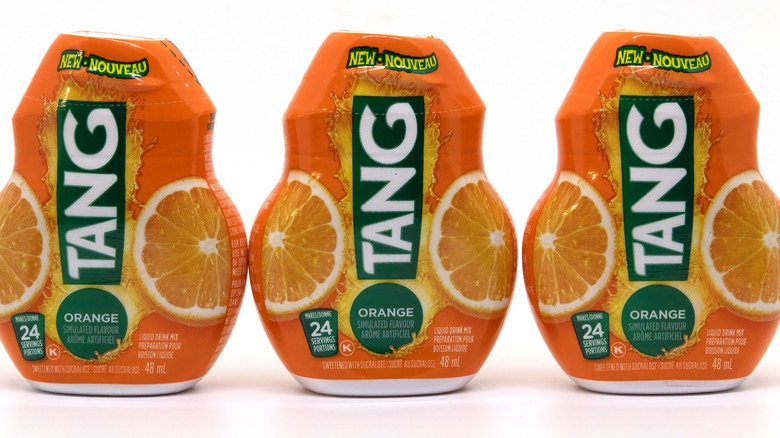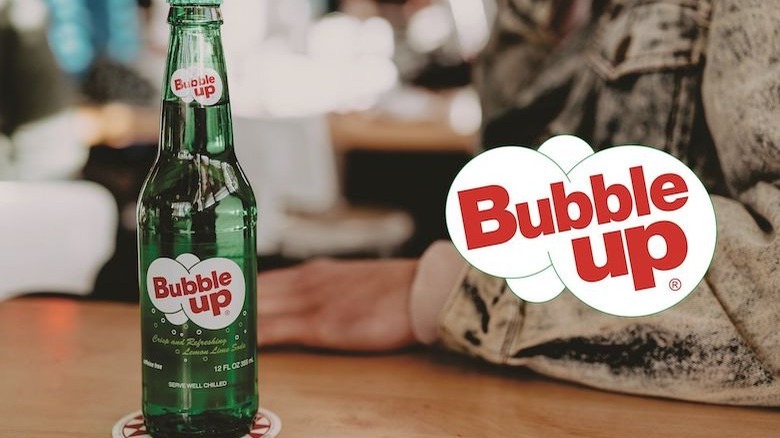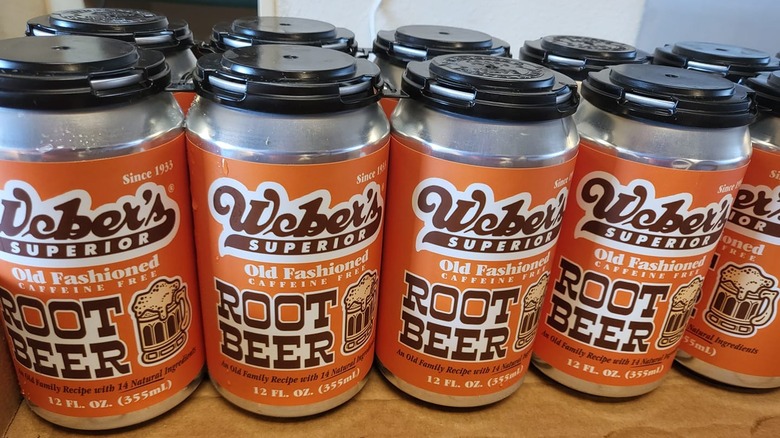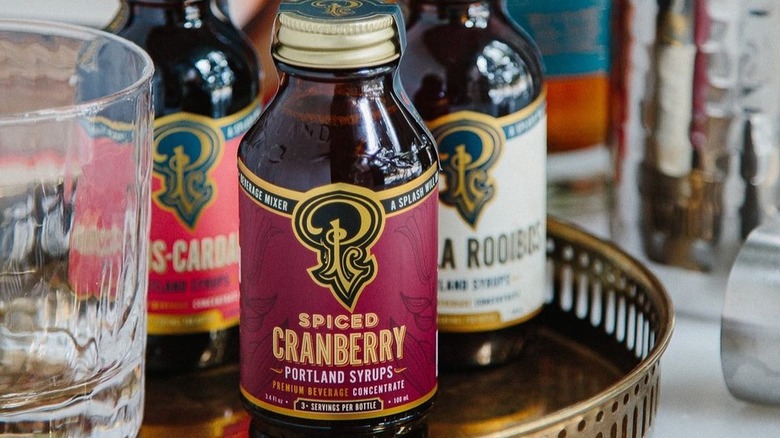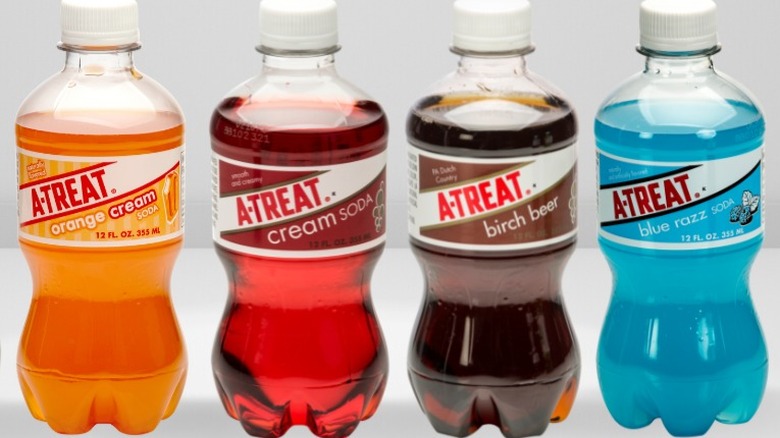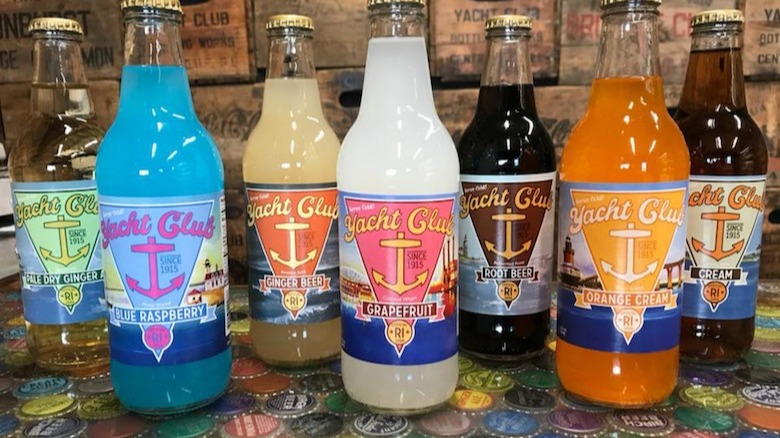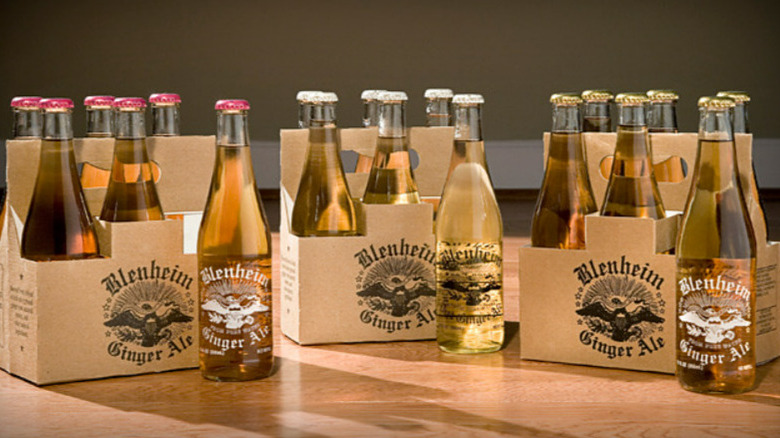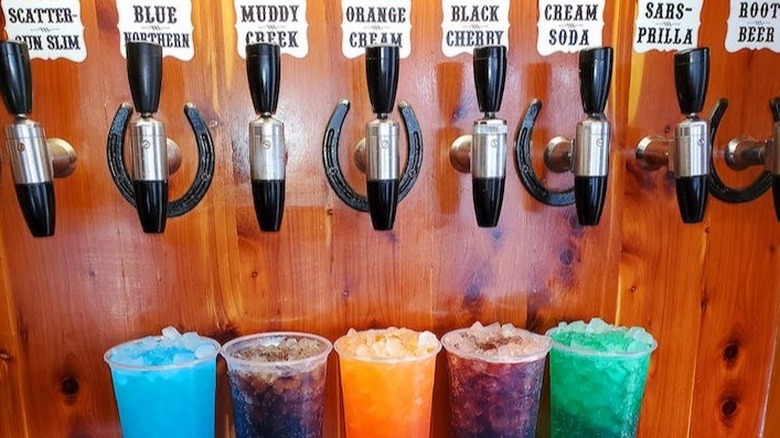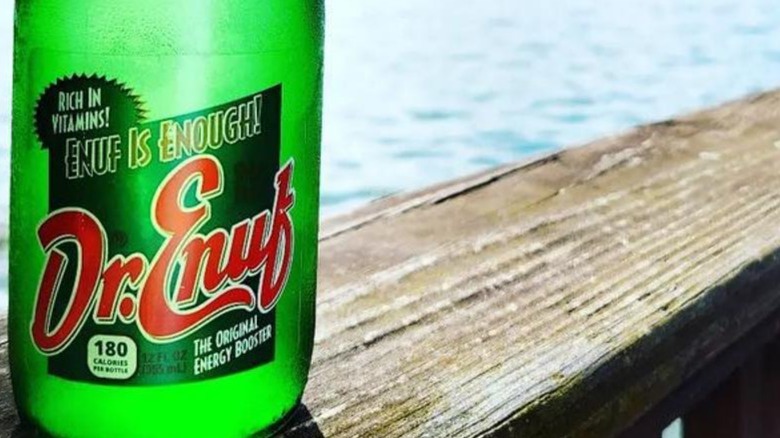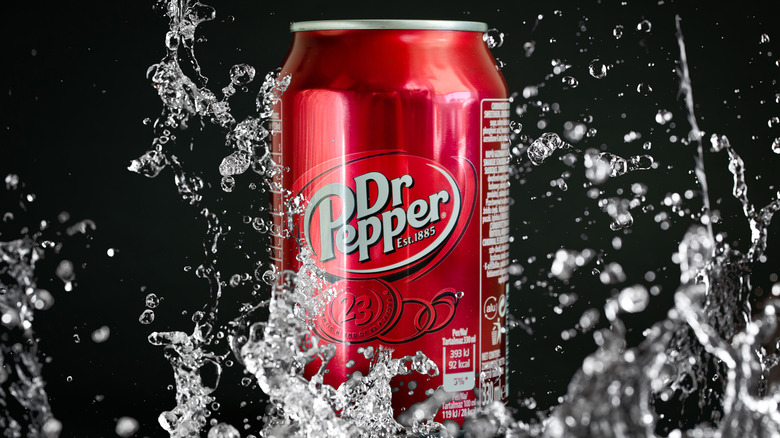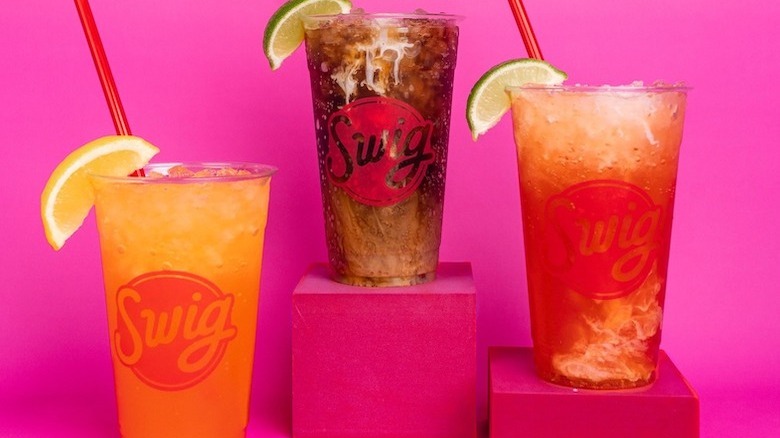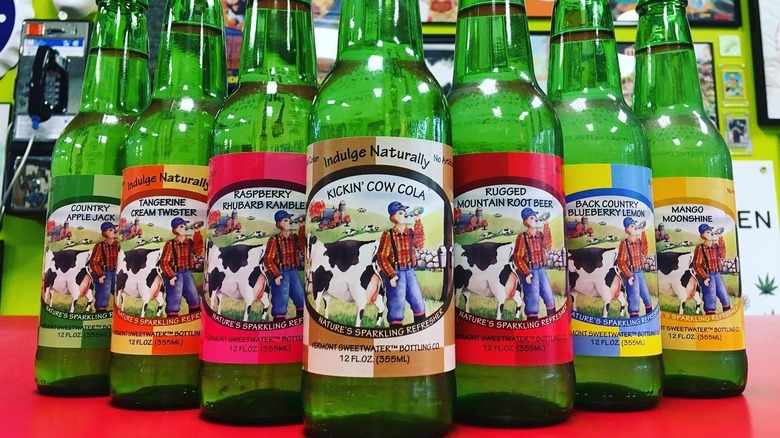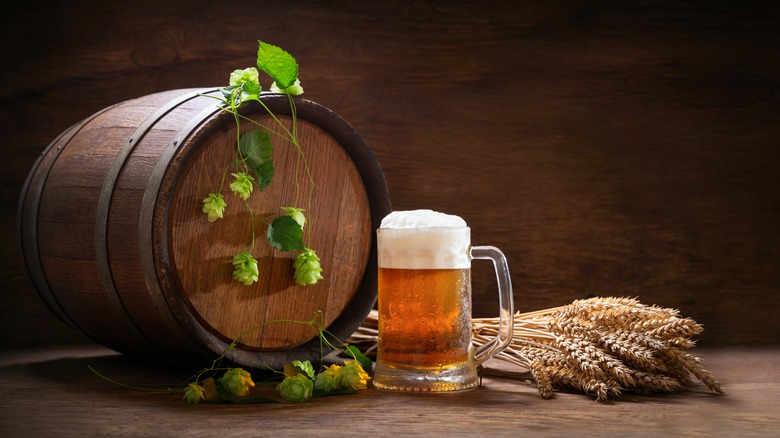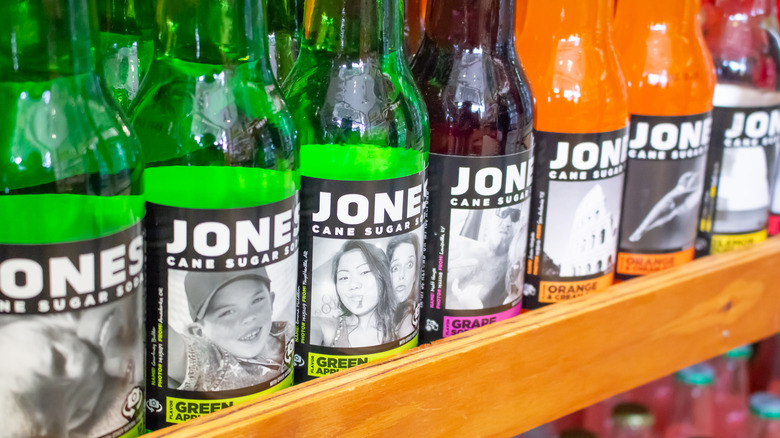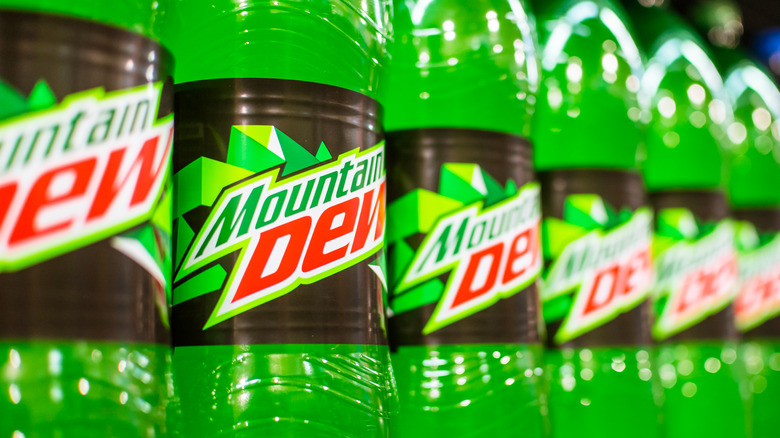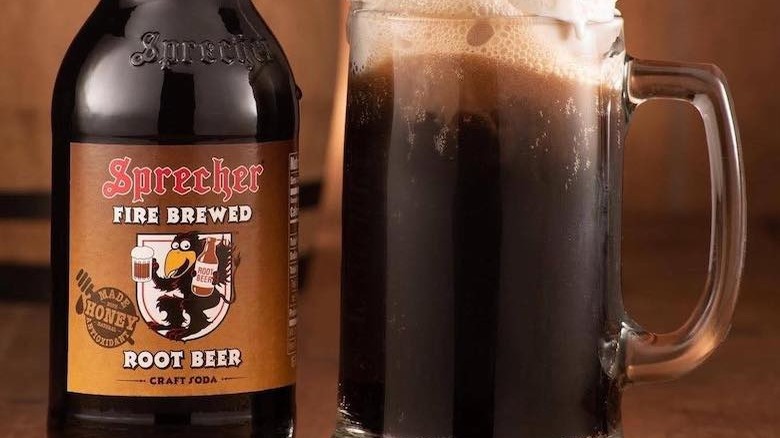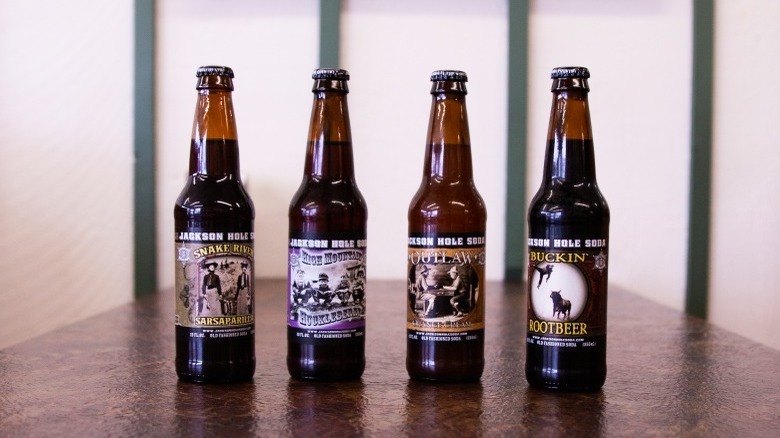Each State's Signature Soda
Whether you call it pop, soda, or coke, fizzy drinks are a popular treat in every state from the shores of Hawaii to the everglades of Florida. According to World Population Review, Americans consume on average 39.6 gallons of soda each year. That's approximately 480 cans of soda, which actually represents a decline over the past few years. Soocial indicates that the age group consuming the most soda is between 30 and 49 years old, and the United States ranks second behind only Mexico in the highest per capita soda consumption globally.
While modern-day soda consumption is linked with an increase in obesity, dental issues, and type 2 diabetes, ThoughtCo. notes that its origins actually came from the belief in the medicinal properties of natural spring water. Mineral water is made bubbly by a natural carbonation process that occurs when the water dissolves the limestone. In the 17th century, the French began flavoring this natural soda with lemon juice and honey, and the commercial soda industry was born.
The first patent for commercial soda production in the U.S. was obtained in 1810, but ThoughtCo. goes on to state that it did not become popularized until 1832. Soft drinks are called "soft" because they do not contain alcohol — something that many early carbonated beverages did contain. Pharmacies that added soda fountains to their regular offerings became ground zero for the proliferation of soda culture until mass production and bottling took over in the 20th century.
Alabama: Buffalo Rock Ginger Ale
Buffalo Rock Ginger Ale was born in 1901 in the basement of a grocery store in Birmingham, Alabama. Inventor Sidney Lee based his recipe on a tonic created by pharmacist Ashby Coleman to help settle stomach aches. Lee's monumental addition was carbonation, which took this spicy beverage to new heights. AL.com notes the signature beverage of the state has survived in spite of numerous challenges ranging from the Great Depression to the saturation of the market with other big-name sodas. Its staying power is a testament to the quality of the product and the loyalty of its fans.
Alaska: Frontier Soda
The brainchild of Forty-Ninth State Brewing, Frontier Soda is Alaska soda at its best. This craft soda is made in small batches using fresh Alaskan glacial water. These sodas are gluten free, vegan, and made without the use of high fructose corn syrup. While the brand features classic cola and root beer varieties, some of its more intriguing and colorful products include flavors like Aurora Borealis Soda, Ripe Raspberry Soda, Spruce Tip Soda, and Wild Blueberry Cream Soda, which one YouTuber declared "might be the best fruity-flavored soda I've ever tasted." The brand also puts out a number of limited-edition flavors with quirky names like Spring Breakup Soda, Endless Summer Soda, and Whiteout Soda.
Arizona: Squirt
Squirt is a grapefruit-flavored soda invented in 1938 by Herb Bishop in Glendale, Arizona. According to Dr Pepper Snapple Group's Squirt product page, Bishop based his formula on a non-carbonated beverage called "Citrus Club." By adding carbonation, he was able to reduce the amount of fruit juice and sugar in the recipe — something considered advantageous in a post-depression era, frugal U.S. economy. The Soda Wiki mentions that in 1941 Disney artist Bruce Bushman designed the mascot "Lil' Squirt," which helped to popularize the beverage across the country. Diet Squirt was the first to use aspartame as a sweetener.
Arkansas: Grapette
Grapette was developed in 1939 and became a success due to its potent grape flavor as well as the unusual container in which it came. The clear, 6-ounce bottle was the first of its kind, allowing consumers to see the bright-colored beverage inside. As the Encyclopedia of Arkansas notes, by the 1970s sales began to decline and the thriving empire all but disappeared. Enter Walmart Inc., which began to use the Grapette line of flavors in its Sam's Choice beverage collection. By 2005, Grapette was available exclusively at Walmart, where it has remained.
California: Shasta
Shasta was founded in 1889 and named after Mt. Shasta. Originally started as a mixer for alcoholic beverages, its ginger ale was introduced in 1931. The company, headquartered in Hayward, California, boasts a number of firsts according to Zippia. It was the first to use steel cans, introduce diet drinks, use 12-ounce aluminum cans, replace sugar with high-fructose corn syrup, and switch its diet line to Splenda. The brand's line of sodas is also gluten-free, allergen-free, and certified Kosher. There are currently 32 flavors available, including cola, creme soda, apple, and root beer.
Colorado: Rocky Mountain Soda Co.
Though Coloradans are generally known for their penchant for craft breweries, there's a company in Denver that has taken this concept and expanded it into the world of soda. Founded in 2009, Rocky Mountain Soda produces top notch, all natural carbonated beverages free of gluten, GMOs, and artificial flavors or colors. Its impressive portfolio of flavors include staples, like Cola, Ginger Beer, Root Beer, and Sarsaparilla. It also features an array of more unusual brews, like Pikes Peak Prickly Pear, Hayden Huckleberry, and Evergreen Elderberry. The best part is that you can make your own variety pack so you can sample them all.
Connecticut: Foxon Park
Considered one of the most well-known soda brands in Connecticut, Foxon Park Beverages in East Haven has been producing high quality carbonated beverages since 1922. Made from real cane sugar, its selection of sodas is impressive, with 17 different varieties to choose from. Though the brand has the standards, like lemon lime, ginger ale, orange soda, and root beer, some of its more unusual offerings have really put the brand on the map. Its Iron Brew soda, which has Scottish origins, is a mash-up of cola, cream, and root beer, while its signature Gassosa soda is an Italian lemon-lime-flavored beverage that reflects the Italian roots of the founders of the brand. Claims to fame include being featured on Food Network's popular show "Food Finds" and being voted "Best of CT" 10 years running by CT Magazine.
Delaware: Old Dominion
Old Dominion beer brewery was located in Dover, Delaware, and offered four flavors including root beer, ginger ale, creamy orange, and black cherry. Its sodas were made exclusively with pure cane sugar and available only in bottle form. When asked by Delaware Today why a beer brewery would delve into the soda-making industry, the answer was to make it kid friendly. And the response to why it added new soda flavors: "Offering only root beer and ginger ale was like brewing only IPAs or Budweiser." Touché. The brewery shuttered its doors in October of 2023, after 20 years in the business, but Old Dominion — and its root beer in particular — is still considered the state's signature soda.
Florida: Mr. Q Cumber
Mr. Q Cumber is a cucumber-flavored soda invented by Global Beverage Enterprises in Ft. Lauderdale, Florida. The company prides itself on manufacturing products that are sustainable, ethically sourced, and health-conscious. Vintage Soda Collector gives this unusual beverage high marks for its crisp flavor that is not only refreshing but surprisingly light. Specialty Sodas notes that the drink has a bit of a cult following with fans writing poems about it. Restaurants love it for its versatility — particularly as an ingredient in cocktails made with vodka, tequila, and gin. If you like cucumbers, you'll love this crisp tasty treat.
Georgia: Coca-Cola
Coca-Cola made its debut at Jacob's Pharmacy in Atlanta, Georgia, in 1886. The brainchild of Dr. John Pemberton, its precursor was a combination of wine and cocaine that was used as an alternative to morphine, according to Oldest.org. Pemberton registered a trademark for his Coca Wine in 1885, but Prohibition was passed in the county the next year rendering it illegal. He reformulated it, added carbonation, and a legend was born. Coca-Cola is now consumed 1.7 billion times a day, which equals 19,400 beverages per second globally. And "Coca-Cola" is universally recognized as the second most-known word behind "okay."
Hawaii: Hawaiian Soda Co.
When it comes to fizzy beverages with the aloha spirit, the Hawaiian Soda Co. has the market cornered. This brand, which was launched in 2023, focuses on producing healthier alternatives to standard sodas. Its products are made using real fruit juice and have no added sugar, artificial flavors, or preservatives. The tropical-inspired drinks come in refreshing flavors like Passion Orange Guava, Lilikoi Lychee, Pineapple Citrus, Grapefruit Blush, and Mango Sunset. Though the headquarters of this brand are located in Honolulu, Hawaii, its products can be found at retailers across the U.S. As the brand's tagline suggests, snatch up a can and "Come get Island Fizzy with US!"
Idaho: BuckSnort Soda Co.
Located in Boise, Idaho, BuckSnort Soda Co. was the brainchild of Kainoa Lopez aka "The Root Beer Guy." Lopez began dabbling in making root beer after being laid off in 2009. He leaned on his Hawaiian roots as the grandson of the founder of Waialua Soda Works and his ingenuity to develop a root beer that tasted like it would have 100 years ago. The resulting brew was bold in licorice roots and made with real sassafras, giving it nostalgic appeal. Today, BuckSnort Soda Co. makes an array of sodas that are free of artificial anything, use only pure cane sugar, and are made in small batches weekly. Varieties include Ginger Beer, Maple Cream Soda, SapSucker Red Cream Soda, and the distinctive Black Sheep, which fuses BuckSnort Root Beer with espresso from Dawson Taylor Coffee Roasters.
Illinois: Green River
Green River citrus soda was invented in 1919 by Richard C. Jones in Davenport, Iowa. As per Atlas Obscura, the recipe was subsequently sold to Chicago-based Schoenhofen Edelweiss Brewing Company where it catapulted to fame. During Prohibition, the brewery was able to stay afloat by putting the green concoction in old beer bottles. Between 1930 and 1950, Green River was so popular in the Midwest that only Coca-Cola outsold it. According to music folklore, the beverage inspired the band Creedence Clearwater Revival's song by the same name. The most popular day to consume Green River soda? St. Patrick's Day.
Indiana: Triple XXX Root Beer
Triple XXX is the name of both a root beer and a restaurant in West Lafayette, Indiana. The brew gets its title from an old classification system ranking items like sugar, gunpowder, and beer kegs on a scale from X (worst) to XXX (best). According to the company's website, in the 1920s, Triple XXX root beer was available across the U.S. and Canada in Thirst Stations and on steamboats navigating the Mississippi River. Another fun fact: According to The Washington Post, Indiana native Ermal Fraze is the inventor of the modern pop-top can, which has revolutionized the soda industry.
Iowa: Sioux City Sarsaparilla
Sioux City Sarsaparilla is one of seven flavors in White Rock's Sioux City line that captures the authentic flavors from the Old West. The brew experienced its fifteen seconds of fame when it appeared in the movie The Big Lebowski. The difference between root beer and sarsaparilla? Traditional sarsaparilla was made from the bitter sarsaparilla vine, while classic root beer was made from sassafras root. Sassafras root was banned in 1960 by the FDA because its essential oil— safrole — is a known carcinogen. Sarsaparilla vine has been substituted in modern versions of the classic to incorporate sweeter flavors.
Kansas: Lost Trail
Lost Trail soda is thought to have been discovered by Joe Marshall in 1848 when he became lost while looking for the Santa Fe Trail — hence its moniker. His granddaughter began making the recipe about 150 years later at her cider mill in Louisburg, Kansas. Gourmet Root Beer notes that the brew has a strong wintergreen taste and a very dark color. The cowboy-clad label has now expanded to encompass a number of flavors including strawberry cream, black cherry, ginger brew, orange cream, and a diet root beer. The cider mill offers tours and year-round activities like a corn maze.
Kentucky: Ale-8-One
Ale-8-One was invented in Winchester, Kentucky, in 1926 by G.L. Wainscott, according to Only in Your State. The name came about when Wainscott created a naming contest to help promote the new ginger-infused beverage. The winning entry was "A Late One," which was a 1920s slang term for "the latest thing." The brew was made Kentucky's "original soft drink" by law in 2013 by Governor Steve Beshear. Production of Ale-8-One has remained a family affair, with Wainscott's great-great-nephew Fielding Rogers currently at the helm. And for those wanting to partake in Kentucky bourbon, Ale-8-One is apparently a great cocktail mixer.
Louisiana: Big Shot
Big Shot Soda is a New Orleans icon that got its start in 1935. The brainchild of Irbin Pailet's Jefferson Brewing Company, New Orleans Magazine notes that part of the success of the brand was its marketing scheme involving cash prizes and bottle caps being exchanged for silver-plated spoons. While the brand has since been sold to a Floridian beverage distributor, it is still mostly consumed within New Orleans. Flavors include pineapple, strawberry, watermelon, peach, cream soda, and the classic root beer. And if you listen carefully, you'll hear a shout-out to the drink in Lil Wayne's 2009 "No Ceilings."
Maine: Moxie
Moxie was invented in 1884 by Dr. Augustin Thompson, a native of Union, Maine. The Matthews Museum of Maine Heritage states that the beverage was considered a kind of early Viagra. Additionally, bartenders served Moxie to customers who had had too much to drink. Maine's official state website notes that "Moxie Nerve Food" has a complex flavor that is simultaneously sweet and bitter as a result of the gentian root extract it contains. In May of 2005, Governor John Baldacci designated Moxie the official state soft drink. The Matthews Museum and Moxie shop is open seasonally.
Maryland: Frostie Old Fashion Root Beer
Frostie Old Fashion Root Beer was invented in 1939 by soda aficionado George Rackensperger, according to The Herald-Dispatch. The root beer was bottled in — of all places — an old jailhouse in Catonsville, Maryland. Rackensperger converted the garage to house his bottling equipment and all of the ingredients needed to manufacture this unique soda. While the original Frostie Bottling Co. folded in 1959, the sweet treat has continued to be manufactured under numerous other labels, including Seven Up. Its current home is in Breese, Illinois, with Excel Bottling Company. It is only available through Walmart and a handful of Cracker Barrel locations.
Massachusetts: Polar
Polar began in 1882 as a sparkling water company in Worcester, Massachusetts. As noted by Inc., water in the city was unsafe for consumption so the Crowley family filled a vital need. The company evolved to sell spirits until Prohibition forced them to shift gears. By the 30s, carbonated beverages became the company's primary focus with orange dry and ginger ale leading the way. The brand continued to grow and add new sparkling fruit-flavored waters throughout the 20th century. Today — under the watchful eye of four generations of Crowley's — Polar Beverages remains the largest independently-owned bottling company in the U.S.
Michigan: Vernors
Vernors signature ginger ale was invented by pharmacist James Vernor of Detroit in 1866, as noted by the Detroit Historical Society. According to folklore, when Vernor left for the Civil War in 1862, he left behind a beverage fermenting in an oak barrel. When he returned, the concoction had adopted a unique characteristic flavor attributable to the oak and Vernors was born. While this story has been contested, the ultra-carbonated beverage is still considered a cure-all for everything from stomach aches to sore throats. In 1967, the company copyrighted the Boston Cooler — a combination of Vernors and vanilla ice cream.
Minnesota: Northern Soda Company
Northern Soda Company is a small, vintage pop company based out of the Twin Cities and is the brainchild of Jesse Hopkins. When the company was started in 2018, the owners insisted on producing small batches of seasonal flavors using the highest quality non-GMO ingredients, notes the Pioneer Press. With experience came growing pains, which necessitated the shift from glass bottles to aluminum cans and graduating to more mass production in 90-gallon tanks. Signature flavors include Due North, North Coast Cooler, Sunday Purple, Pontoon Punch, and Butterscotch Root Beer. The logo has a retro feel, hearkening back to old-time soda fountains.
Mississippi: Barq's Root Beer
Barq's Root Beer was invented by Edward C. Barq Sr. in 1897 in Biloxi, Mississippi. In the 1920s, the beverage became a fetish due to Prohibition. From 1970-1979, corporate headquarters were relocated to Edward's hometown of New Orleans. With the advent of the disco era, Sugar-Free-Barq's Root Beer was invented to accommodate the burgeoning diet fad. By 1993, "The One with Bite" was being consumed by millions of happy customers in 440 markets across the U.S. In 1995 Barq's Inc. was acquired by the Coca-Cola Company and its headquarters moved to Atlanta, where it remains today.
Missouri: Ftiz's Root Beer
Fitz's Root Beer was developed in 1947 in St. Louis, Missouri. The historic brew is now recreated in 15-gallon barrels in the bottling room of Fitz's Bottling Company restaurant and brewery. The brewery — opened in 1993 — operates with a refurbished 1940s bottling line discovered in an old barn in Shawano, Wisconsin. It is housed in a 1928 building that was once a bank in the historic Delmar district of St. Louis. Explore St. Louis suggests enjoying Fitz's signature burgers and barbecue alongside its craft beer and numerous soda flavors, including cream soda, orange pop, and black cherry.
Montana: Flathead Lake Gourmet Soda
Flathead Lake Gourmet Soda is named after the famed Flathead Lake region of Montana. According to Flathead Lakers, legend has it that the lake is home to a mysterious monster. The creature is described as being a large, eel-shaped amphibian that is blackish blue in color, has steel-black eyes, and ranges from 6 to 40 feet long. The Flathead Lake brand was acquired by family-owned North American Beverage Co. in the early 2000s. Its flavors — including Huckleberry, Sour Cherry, Black Raspberry, Granny Apple, and Strawberry Orange — are designed to ease consumers into less conventional soda offerings.
Nebraska: Goody Soda
Goody Soda was the invention of the Willow Springs Bottling Company, which was established in Omaha, Nebraska in 1919, per Retro Planet. The company evolved from the Willow Springs Distillery after Prohibition put an end to its manufacture of alcoholic beverages. The beverage bottle featured a quirky-looking boy named "Goody," who was instrumental in marketing the brand. Goody continued to be produced through the 1970s, after which it disappeared. In 2012, it resurfaced and is now part of the Orca Beverage, Inc. catalog. It is made in four flavors: berry cream, green apple, pineapple, and bubble gum.
Nevada: HaHa Soda
HaHa Cannabis Infused Soda is the next generation of cannabis-infused consumables. Per Vegas Publicity, Planet 13 — billed as the world's largest Cannabis SuperStore in 2021 — has developed a new line of soda laced with 10 milligrams of THC. The sodas — made with pure cane sugar — come in retro flavors such as Old School Root Beer, Ludicrous Lemon-Lime, and Guzzle It Grape. The soda line is said to be a refreshing blend of a tasty treat with mild psychoactive properties. Planet 13 does warn that there is a delayed response to the THC kicking in after consumption, so guzzle with caution!
New Hampshire: Squamscot Soda
Squamscot Soda began in 1863 in Newfields, New Hampshire. Invented by William H. Connor, the "pop" beer — named "Connormade" — was a tonic or spruce beer that came in reusable glass bottles with porcelain and wire tops. In 1938, Connor Bottling Works acquired "Dixie" — its faithful bottling machine — which is still in operation today. A fifth-generation family affair, it's the last independent bottler in the state of New Hampshire. While it boasts 27 flavors of sodas, the most popular is the Mistletoe Mist, which is only available for the holidays and sells out quickly.
New Jersey: Boylan Bottling Company
Boylan soda originated in 1891 in Paterson, New Jersey. Pharmacist William Boylan invented an elixir named "Boylan's Birch," which he sold by the cupful off the back of a wagon. According to Imbibe, birch beer is a quintessentially northeastern staple dating back to pre-Revolutionary times. Its strong wintergreen-forward flavor makes it unsuitable as a mixer for alcoholic beverages, setting it apart from some of the more modern flavors put out by Boylan, like black cherry, orange, and grape. Part of this brand's unique heritage is its long-neck embossed glass bottle, which has remained virtually unchanged since its invention.
New Mexico: Zia
Zia is a small, craft soda manufacturer in New Mexico that uses local ingredients to cultivate unique flavors like pinon cola, nopales, sandia, and ginger ale. Its logo is the "Zia" or Pueblo sun symbol, which can also be seen on the New Mexico state flag. According to the Sante Fe New Mexican, owners Ezra and Sonia Leyba obtained permission to use the symbol from the Pueblo by agreeing to share profits with them. Zia is bottled in a brewery, and its root beer has fermented barley added to it, giving it the flavor of a microbrew without the alcohol.
New York: Dr. Brown's
Dr. Brown's soda began in 1869 when Jewish Dr. Brown began selling his celery "tonic" to local delicatessens in New York's Lower East Side. Dubbed "Jewish Champagne," The Nosher notes that the beverage had to be renamed to "Dr. Brown's Cel-Ray Soda" due to the Food and Drug Administration's concerns over the dubious medical claims made regarding the beverage. The vast catalog of flavors is no longer restricted to delis and Jewish holidays and is now found in mainstream grocery stores and restaurants globally.
North Carolina: Pepsi
Pepsi was developed in 1893 by pharmacist Caleb Bradham in New Bern, North Carolina (via PepsiCo). First named "Brad's Drink," it was renamed "Pepsi-Cola" and trademarked in 1903. By 1910, there were 240 franchises in 24 states. In 1939, Pepsi invented the first radio jingle promoting the brand throughout the U.S. This was subsequently adapted for television in 1950. The signature Pepsi swirl bottle was introduced in 1958. By 1977, Pepsi-Cola had become the most popular cola drink in supermarkets. The corporation is still headquartered in North Carolina, where you can visit the official birthplace and Pepsi Store.
North Dakota: Tang
Tang might not be a soda, but it is a beverage that has its roots in North Dakota. It was developed in 1957 after two years of research and development. In 1965, Tang made its debut as a nutritional supplement for Gemini 4 astronauts and continued to be used on manned space flights for 10 years. Reinforcing its connection with the space program — in 1968, the brand sponsored the television coverage of the Apollo 8 mission to the moon. Today, Tang is available in over 30 countries around the world and brings in over $700 million dollars in net revenues.
Ohio: Bubble Up
Bubble Up is a lemon-lime beverage that was invented by Sweet Valley Products Co. of Sandusky, Ohio, in 1919. It was originally touted as a grape beverage but by 1938, it was developed into a lemon-lime drink by LeRoy O. Schneeburger, per The Soda Wiki. It has since made many cross-country trips as the brand shifted hands from company to company, ultimately landing under the umbrella of the Dad's Root Beer family. A "Kiss of lemon – Kiss of lime," the brand has expanded to include cloudy lemon, bitter lemon, diet, tonic, club soda, and ginger ale flavors.
Oklahoma: Weber's Superior Root Beer
Weber's Superior root beer is an Oklahoma staple that is now a fifth-generation family affair. Invented in 1891 at the Weber family farm in Tulsa, Oklahoma, by Oscar "Weber Bilby," the concoction is made of 14 secret ingredients. The brew was originally carbonated with yeast, "fire-brewed," and aged in birch bark barrels. It can now be sampled exclusively at Weber's Superior Root Beer restaurant in Tulsa, Oklahoma. Established in 1933, the restaurant is known for its astounding burgers, which pair well with a root beer float served in an ice-cold frosted mug.
Oregon: Portland Soda Works
Portland Soda Works is a homegrown soda company out of Portland, Oregon. The passion project of Chris Onstad and Dan McLaughlin, the pair started the company in 2012 out of a rented commissary kitchen. In 2015, the company moved to a newer facility built in a 100-year-old bakery. Its claim to fame is the diverse profile of offerings produced ranging from a myriad of flavored sodas and sparkling waters to its signature syrups and mixers for cocktails. There is even have a Mocktail Club subscription, which comes with a recipe and all the fixings for a delicious treat.
Pennsylvania: A-Treat
A-Treat is quintessential Allentown, Pennsylvania, in a bottle. This soda was developed by Joe and Jack Egizio in 1918 in the confines of their garage. In 1932, the operation moved to a larger facility where they bottled their soda for 83 years. After a brief hiatus, the brand was bought by Jaindl Companies in 2015. Jaindl Companies prides itself on using flavorings made in-house out of essential oils rather than commercially produced syrups. The brand's cream soda was named one of the "100 Best Things About the Lehigh Valley." Fan favorites include birch beer, grapefruit, blue razz, and black cherry.
Rhode Island: Yacht Club
Yacht Club soda is the "official soda of Rhode Island." A family-owned business that opened its doors in 1915, it offers 24 flavors of soda, seltzer, and tonic waters, as well as seasonal specialties. According to Eat Drink RI, in 2016 the company made waves with its first politically themed flavors: Hillary's Liberal Limeade and Donald's Populist Punch. The "Soda Pop Poll" was intended to lighten the mood of a contentious political season. The secret to the soda's success is in the quality of its water, which is ideal for carbonation and enables the company to make it without adding salt.
South Carolina: Blenheim Ginger Ale
Blenheim Ginger Ale is the product of Blenheim Springs, a mineral-rich spring discovered in 1781 by James Spears. In the late 1800s, Dr. C. R. May began supplementing the tinny-flavored miracle water with Jamaican ginger to make it more palatable. May and A. J. Matheson opened the Blenheim Bottling Company in 1903 and a legend was born. As Discover South Carolina notes, this tonic is very spicy and comes in three flavors: Old No. 3 (with a red cap), No. 5 Not as Hot (with a gold cap), and #9 Diet (with a white cap).
South Dakota: Wild West Soda
Wild West Soda — located near Mount Rushmore in Keystone, South Dakota — is a partner with the Wild West Pecan Company. The two companies create old-fashioned style sodas using only the highest quality, natural ingredients. The sodas are served in collectible tin cups that have become something of a novelty. Some of its frontier-inspired flavors include sarsaparilla, muddy creek (chocolate soda), wild cherry lime aid, scatter gun slim (diet root beer), and black cherry. It also has a new line of Outlaw Sodas — variations of the classic creme soda — called Pecos peach, red bandit, and blue bonnet.
Tennessee: Dr. Enuf
Dr. Enuf was invented in 1949 by chemist Bill Swartz as a miracle cure for all forms of ailments ranging from fatigue to stomach aches. In 1951, Swartz partnered with Charlie Gordon to develop a bottling company — now called Tri-City Beverage Company — in Johnson City, Tennessee. The Herbal Dr. Enuf — which is laced with vitamins and caffeine — is like the precursor to Red Bull. According to Made in Tennessee, while Dr. Enuf became the token beverage, the brand was also the first bottler of Mountain Dew. Tours of the bottling company are available by reservation only.
Texas: Dr. Pepper
Dr. Pepper is one of the oldest sodas in the U.S., and was invented by pharmacist Charles Alderton at a corner drug store in Waco, Texas, in 1885. According to the Texas Standard, the original name of the soda was Waco. It didn't get its current moniker until the owner of the drug store wanted to impress the father of the woman he loved by naming his soda after him. He didn't get the girl, but he got rich. Contrary to popular belief, there is no prune juice in the recipe. The Dr. Pepper Museum is open for tastings, tours, and special events.
Utah: Dirty Soda
Dirty Soda is the brainchild of Nicole Tanner who set up Swig soda shop in St. George, Utah, in 2010. Per Yahoo Entertainment, the phenomenon — inspired by a Sonic drive-through — didn't catch on until 2021 when singer Olivia Rodrigo posted a photo of herself with one of the shop's delectable sweet concoctions on Instagram. #dirtysoda instantly became a viral trend on Tik Tok with over 112 million views. In some ways, Dirty Soda is like the Coldstone Creamery of sodas — you pick the soda and flavors you'd like and they combine them for a tasty, customized treat.
Vermont: Vermont Sweetwater
Vermont Sweetwater is a bottling company located in Poultney, Vermont. The family-owned operation produces beverages infused with Vermont sugar maple sap. What could be more Vermontian? While the company began with only Maple Seltzer, it introduced Vermont Maple Soda in 1996. With the millennium around the corner, it branched out into fruit flavors and colas. It now has 12 flavors, including country apple jack, mango moonshine, raspberry rhubarb ramble, tangerine cream twister, and kickin' cow cola. All of its products are made without artificial colors, flavors, or preservatives and come in either a six-pack container or a 24-pack case.
Virginia: Craft Beer Breweries
Craft Beer Brewery Mecca. While this may seem like a stretch, Virginia wasn't particularly known for a specific soda. However — as Virginia Is For Lovers suggests — the state is apparently rife with craft beer breweries, many of which offer non-alcoholic options for their patrons. Bingo! In fact, there are eight Craft Beer Trails listed on their website, including the Brew Ridge Trail, Spirits of the Clinch, Beltway Beer Trail, and Helltown Beer Trail. Many of these breweries offer tours, fine dining, and of course tastings of their specialties. They might not exactly be soda, but they are bubbly.
Washington: Jones Soda
Jones Soda Co. — headquartered in Seattle, Washington — was created in Vancouver, B.C. in 1995 by Peter van Stolk and photographer Victor John Penner. Its hook was to feature Penner's photos on the labels of their offerings like blue bubblegum. Stolk and Penner soon realized that using photos submitted by consumers created greater brand loyalty and they began incorporating them. According to CNBC, in 2022 the brand expanded to include products under the umbrella of Mary Jones cannabis-infused sodas and gummies. According to Jones Soda, these beverages contain 10 milligrams of THC per can and come in flavors like orange & cream, green apple, and berry lemonade.
West Virginia: Mountain Dew
While Mountain Dew originated in the foothills of the Smokey Mountains of Tennessee, it is wildly popular in West Virginia. In an Eater essay, Sarah Blind describes the soda as, "...a highly-carbonated, nose-tickling bubble and a tart-sweet, citrusy flavor that's similar to a church picnic punch on steroids." In an interview with NPR, research analyst Dana Singer said, "Here in West Virginia, you see people carrying around bottles of Mountain Dew all the time — even at a public health conference." The reason for its popularity is attributed to several factors, including being highly habit-forming and the residents' concerns over the safety of local drinking water.
Wisconsin: Sprecher Brewing Company
Sprecher Brewing Company is the oldest brewery in Milwaukee, Wisconsin, dating back to 1984. It is the brainchild of Randy Sprecher, who developed an affinity for German beer when he was drafted during the Vietnam war. The brewery uses a fire-brewing process combined with Wisconsin honey, which creates the distinctive flavors of both the brand's beer and sodas. Per OnMilwaukee, soda production now outpaces beer production, with the company's root beer being its best seller. It also offers seasonal brews like its late summer blueberry flavor, red raspberry, red apple, and strawberry. Tours are offered by reservation only, Wednesday through Saturday.
Wyoming: Jackson Hole Soda
Jackson Hole Soda captures the pioneer spirit of the wild, wild west. Its signature flavors are "as varied as the sun setting over our beautiful Grand Tetons" and hearken back to old-time soda fountain culture. While the brand highlights its multiple award-winning batch-brewed Buckin' Rootbeer and its customer favorite High Mountain Huckleberry, which is perfect on a hot day, all of the flavors, including Grand Teton Grape, Jackson Ginger, Outlaw Orange Cream, South Fork Strawberry Rhubarb, Cherokee Cherry Vanilla, and Western Watermelon will put a smile on your face.
